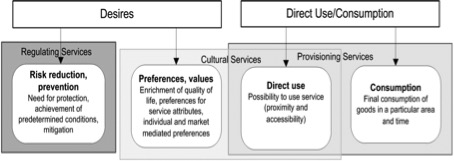
Mapping the demand for ecosystem services (ES) has received increased attention in scientific research and is seen as a relevant tool to inform conservation planning, land- use planning and management. Yet, to improve indicator quality and policy relevance of ES demand maps, there is a need for a shared understanding of demand as well as robust, credible, and accurate indicators for demand.
A recently published literature review on ES demand, by S. Wolff, C. J. E. Schulp and P.H. Verburg, shows that there is no agreement on the concept of ES demand, which has implications on how and where ES demand is being mapped. The review focuses on the current conceptual understanding of ES demand, indicators to measure demand, as well as approaches used to quantify and map demand. Four distinct “demand types” were identified which relate to different ecosystem service categories. These demand types include demand expressed in terms of (1) risk reduction, (2) preferences and values, (3) direct use or (4) consumption of goods and services.

Classification of demand types. Desires and consumption or direct use are two main categories used to quantify demand in the reviewed studies. Desires including the need for risk reduction/prevention and preferences are used predominantly to quantify demand for regulating services and cultural services respectively. Demands for provisioning services are mostly quantified by the direct use and consumption of goods. Cultural services are assessed by both preferences and values, as well as the direct use of recreational or cultural sites.
While current ES demand maps follow the rationale to support the operationalization of the ES concept in planning, management and policy, few of the reviewed studies provide actual examples of demand indicators or mapping into policy and practice. By using the characteristics of demand for different ES categories, the study provides a structural framework to guide indicator and method selection and thus, to improve mapping for several underrepresented services. The study emphasizes the need for further research to focus on an improved understanding of processes underlying the demand for different ES. This will allow including spatial temporal dynamics, as well as studying the demand for multiple ES as a driver of land- use change. The findings of this review will serve as a framework to guide indicator and method selection to map selected non-commodity ES at the global scale.
Reference: S.Wolff, C.E.J. Schulp, P.H. Verburg (2015) Mapping Ecosystem Services Demand: A review of current research and future perspectives. Ecological Indicators, 55, 159-17. Doi: 10.1016/j.ecolind.2015.03.016
Link to the paper: http://www.sciencedirect.com/science/article/pii/S1470160X15001405
